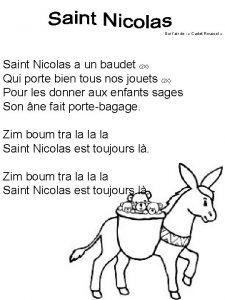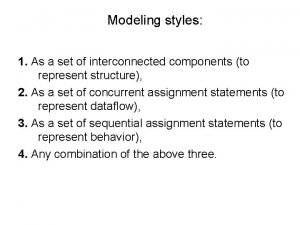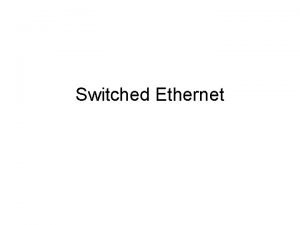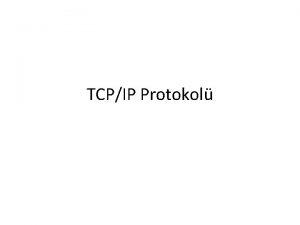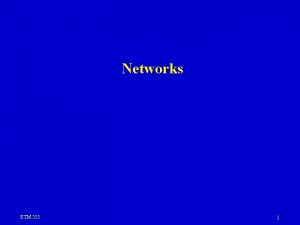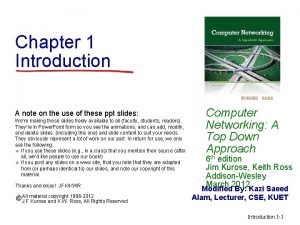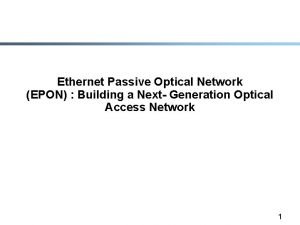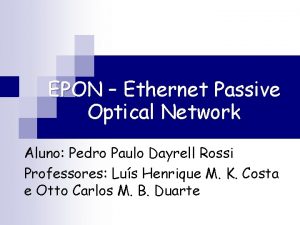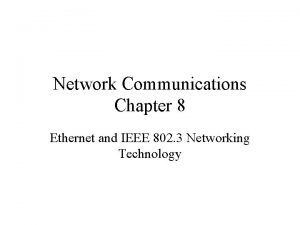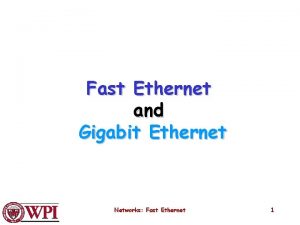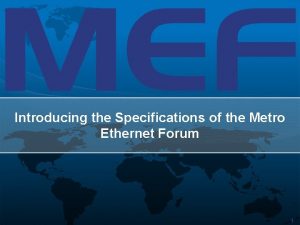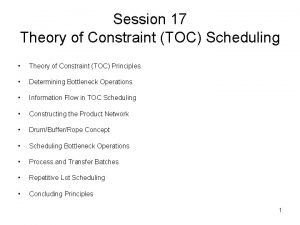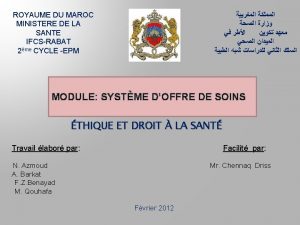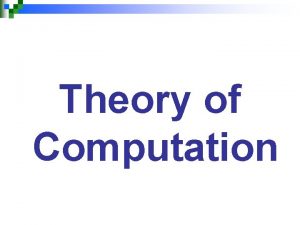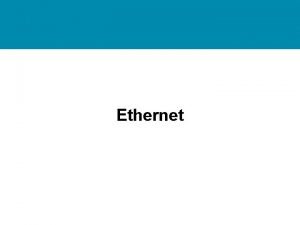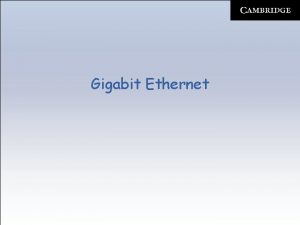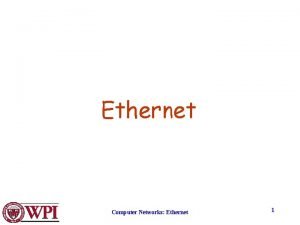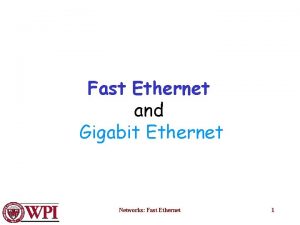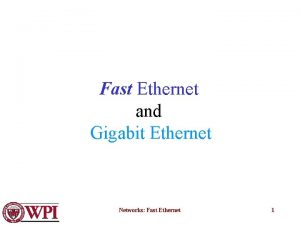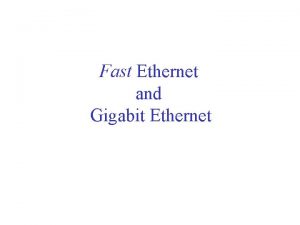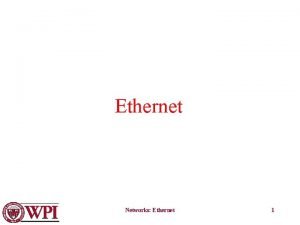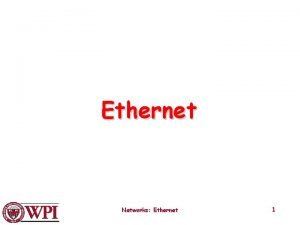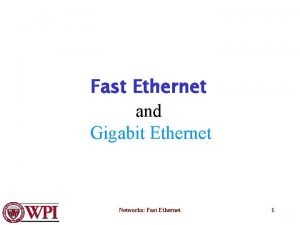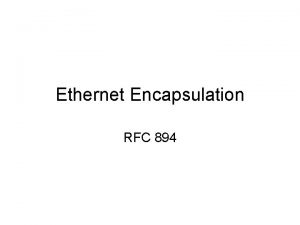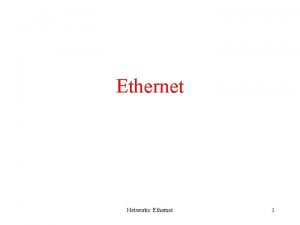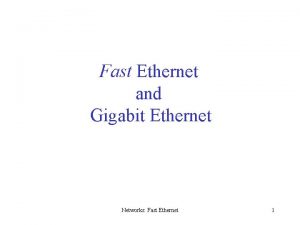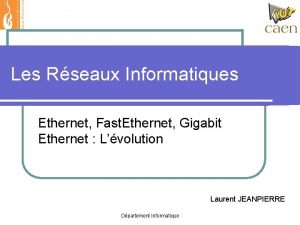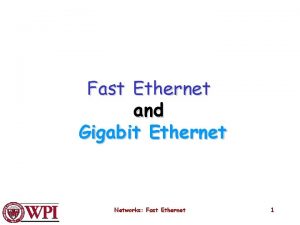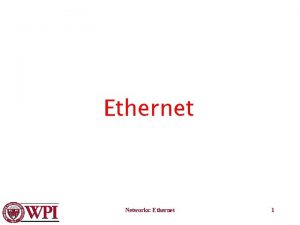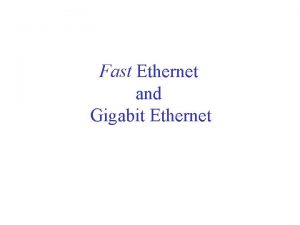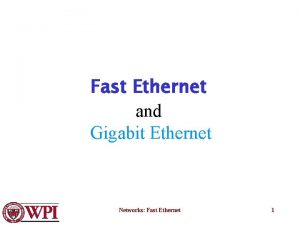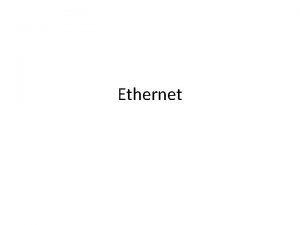TOC Introduction Network Examples Network Components Ethernet Interconnected
































- Slides: 32

TOC: Introduction Network Examples Network Components Ethernet Interconnected LANs Internetwork Types of Networks Internet Packets Transport EECS 122 - UCB 13

Introduction: Network Examples UCB Backbone: n n n Teleglobe Global Crossing Williams Regional: Palo Alto Types of Networks Internet Packets Transport EECS 122 - UCB 14

Network Examples: UCB SODA E 3 BACKBONE 2 nd Floor Cory E 1 E 2 1 st Floor Cory REGIONAL LOCAL EECS 122 - UCB CAMPUS EVANS 15

Network Examples: Backbone Teleglobe Communications Corporation – Fiber + Satellite EECS 122 - UCB 16

Network Examples: Backbone Global Crossing Corporation EECS 122 - UCB 17

Network Examples: Backbone Williams Communications EECS 122 - UCB 18

Network Examples: Regional Palo Alto Network EECS 122 - UCB 19

Introduction: Network Components Links: carry bits from one place to another (or maybe to many other places) Interface: attaches device to link Switch/router: interconnect links Host: communication endpoint (workstation, PDA, cell phone, toaster, tank) – connected to links EECS 122 - UCB 20

Network Components: Links Fibers Cat 5 Unshielded Twisted Pairs Coaxial Cable Wireless EECS 122 - UCB 21

Network Components: NIC Ethernet Network Interface Card EECS 122 - UCB 22

Network Components Telephone Switch EECS 122 - UCB Large Router 23

Introduction: Ethernet is a Local Area Network (LAN) • Architecture: Switch and/or Hub • System View: Services EECS 122 - UCB 24

Ethernet: Architecture Switch and/or Hub: EECS 122 - UCB 25

Ethernet: System View Ethernet is a broadcast-capable, multi-access LAN Provides a “Link” service between nodes Abstract view: EECS 122 - UCB 26

Introduction: Interconnected LANs interconnected by routers LAN 2 LAN 1 R 1 LAN 3 EECS 122 - UCB R 3 R 2 R 4 Internet 27

Introduction: Internetwork Provides message delivery between multiple networks that may belong to different organizations: ISP 1 Subnet 1 ISP 2 Subnet 2 Example: Subnet 1 = network of LANs of previous slide ISP 1 = Sprint, ISP 2 = MCI Subnet 2 = UCB network EECS 122 - UCB 28

Introduction: Types of Network Classification 1: Size, Information, Application Classification 2: Use, Protocols, Technologies Switching Broadcast vs. Switched n Characteristics n How to switch n Taxonomy n EECS 122 - UCB 29

Types of Network: Classification 1 Geographical distance n Local Area Networks (LAN): Ethernet, Token ring, FDDI Metropolitan Area Networks (MAN): DQDB, SMDS n Wide Area Networks (WAN): X. 25, ATM, frame relay n Caveat: LAN, MAN, WAN may mean different things: Service, network technology, networks n Information type n Data networks vs. telecommunication networks Application type n Special purpose networks: airline reservation n General purpose network: Internet network, banking network, credit card network, telephony, CATV EECS 122 - UCB 30

Types of Network: Classification 2 Right to use Private: enterprise networks n Public: telephony network, Internet n Protocols: Proprietary: SNA, Apple. Talk n Open: IP n Technologies Terrestrial vs. satellite n Wired vs. wireless n EECS 122 - UCB 31

Types of Network: Broadcast vs. Switched Broadcast Network: Switched Network: EECS 122 - UCB 32

Types of Network: Characteristics Broadcast n n n One to all Examples: some LANs (Hub-Ethernet, 802. 11) Problem: coordinate the access of all nodes to the shared communication medium (Multiple Access Problem) Switched n n n One to subset Examples: WANs (Telephony Network, Internet) Problem: how to forward information to intended node(s) w This is done by special nodes (e. g. , routers, switches) running routing protocols EECS 122 - UCB 33

Types of Network: How to Switch? Circuit-Switched: 1. 2. 3. Set up circuit between two devices Exchange information Release circuit Packet-Switched: n Send packets with source and destination addresses Vircuit-Circuit Switched: 1. 2. 3. 4. Select path from source to destination (Virtual Circuit) Assign a “label” to that path Send packets with that label Release Virtual Circuit {Note: Some VCs are permanent. } EECS 122 - UCB 34

Types of Network: Taxonomy Based on the way in which the nodes exchange information: Switched Circuit Telephone EECS 122 - UCB Virtual Circuit MPLS ATM Frame Relay Broadcast Packet Sw. -Ethernet Internet Hub-Ethernet CATV 35

Introduction: The Internet Overview Scale EECS 122 - UCB 36

Internet: Overview A global network of networks all using a common protocol (IP, the Internet Protocol) Focus of this class A challenge to understand: n n large scale (10’s of millions of users, 10’s of thousands of networks) heterogeneity, irregular topology, decentralized management EECS 122 - UCB 37

Internet: Scale • Data from www. nw. com EECS 122 - UCB 38

Introduction: Packets Illustration Main Ideas EECS 122 - UCB 39

Packets: Illustration B 1 A | B |. . . 2 3 A B port 2 EECS 122 - UCB 40

Packets: Main Ideas The switches have no memory of packets: scalability The network is independent of the applications: flexibility The packet formats and addresses are independent of the technology: extensibility EECS 122 - UCB 41

Introduction: Transport Acknowledgments Link Sharing EECS 122 - UCB 42

Transport: Acknowledgments The destination sends back an acknowledgment for every correct packet it gets. The source uses these ACKs to - Retransmit unacknowledged packets - Adjust the rate of its transmissions. EECS 122 - UCB 43

Transport: Link Sharing Shared links The sources base their transmissions on when they get acknowledgments. The scheme regulates the sharing of common links EECS 122 - UCB 44
 Chanson bourricot l'âne de saint nicolas
Chanson bourricot l'âne de saint nicolas Pou ki moun pale kristal lyrics
Pou ki moun pale kristal lyrics Set of interconnected components
Set of interconnected components Switched ethernet vs shared ethernet
Switched ethernet vs shared ethernet Internet
Internet Chapter 5 business in a global economy
Chapter 5 business in a global economy Interconnected systems framework
Interconnected systems framework Osi vs tcp/ip
Osi vs tcp/ip Too interconnected to fail
Too interconnected to fail Consider three lans interconnected by two routers
Consider three lans interconnected by two routers Interconnected computer networks that
Interconnected computer networks that Osi reference model ppt
Osi reference model ppt Ethernet b
Ethernet b Ethernet pon
Ethernet pon Gigabit ethernet passive optical network
Gigabit ethernet passive optical network Ethernet network interface card
Ethernet network interface card Fast ethernet in computer networks
Fast ethernet in computer networks Metro ethernet architecture
Metro ethernet architecture Toc in education
Toc in education Toc in pharmaceutical industry
Toc in pharmaceutical industry Toc mérés
Toc mérés Toc scheduling
Toc scheduling Toc doc maroc
Toc doc maroc Toc doc maroc
Toc doc maroc Vận tốc góc
Vận tốc góc Anatel toc
Anatel toc Hai bà trưng
Hai bà trưng Bio toc
Bio toc Tóc demi garcon là gì
Tóc demi garcon là gì Toc 계산
Toc 계산 Noiafrem
Noiafrem Transition graph examples
Transition graph examples Tp analyzer
Tp analyzer
